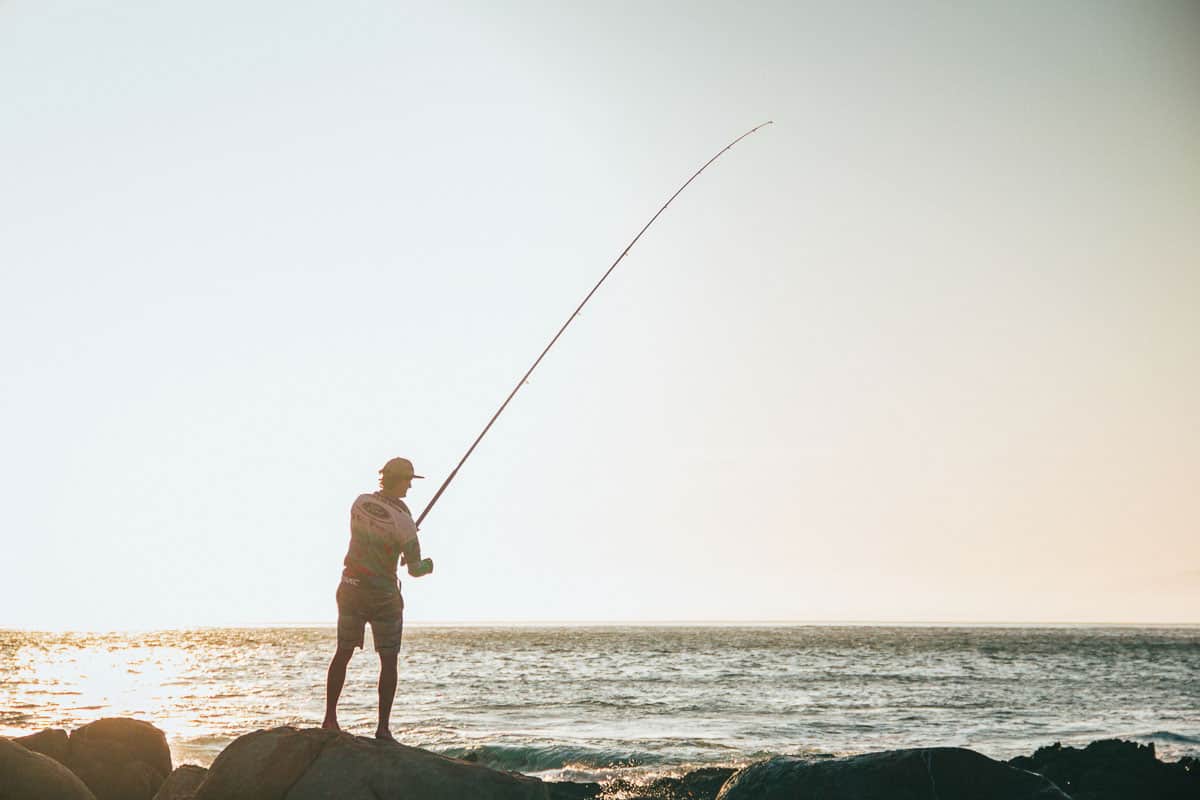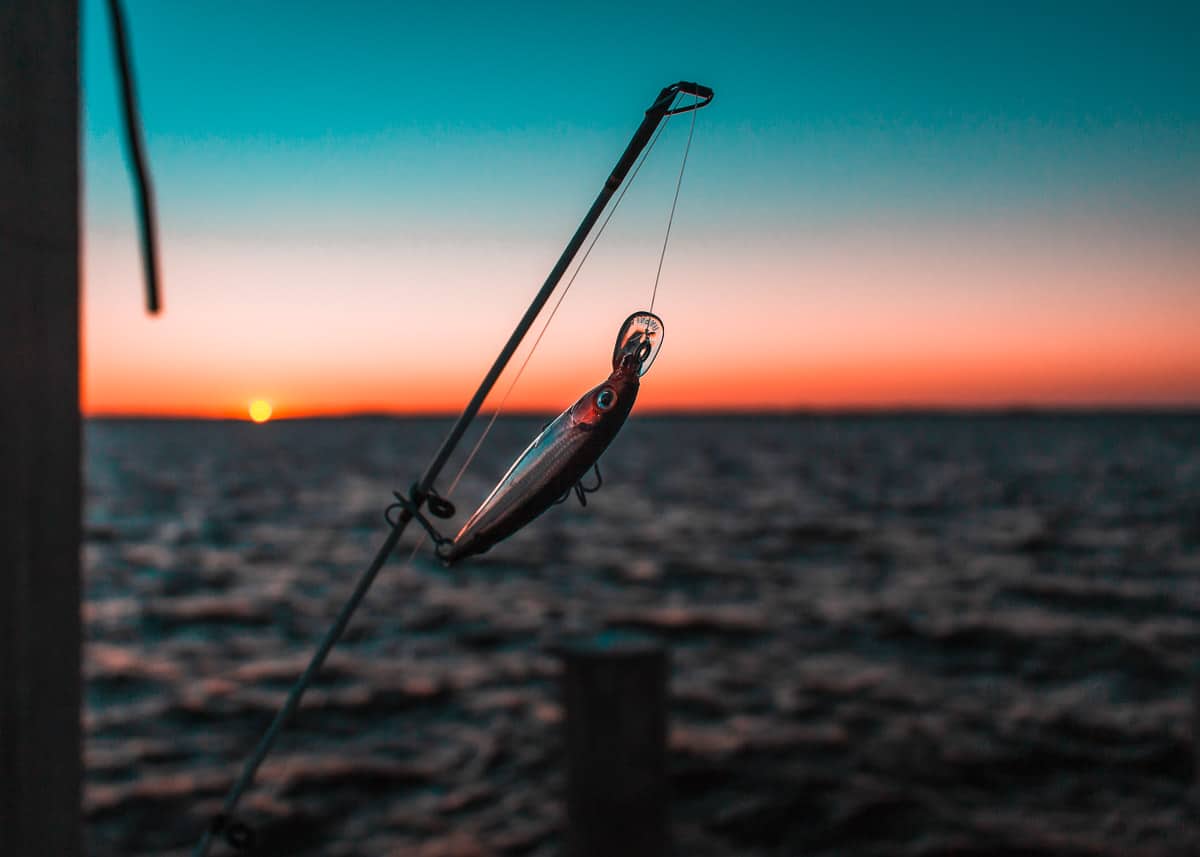Whether you’re a seasoned fluorocarbon user looking for a new line or a new angler wondering what fluorocarbon lines actually are, we are here to help. We’ve rounded up the ten best fluorocarbon fishing lines from a variety of manufacturers and reviewed them for you, with ratings for strength, memory, knotting and abrasion resistance. The reviews also provide the specifications and pros and cons for each line in the list. If you are looking for information on fluorocarbon lines and their benefits then our Buyers Guide and FAQs will help you decipher the terminology and decide what you need to look for when buying the best fluorocarbon fishing line.
BEST FLUOROCARBON FISHING LINE IN 2023
ALL THE FISHING PLIERS THAT WE TESTED
RUNCL Fishing Pliers S1
General Impression
While it may not be the number one Berkley product on this list, Trilene 100% is still some of the best fluorocarbon fishing lines for bass and other freshwater species.
In most cases, fluorocarbon is designed to be denser, more abrasion resistant, and sensitive than competing monofilament brands. So naturally, that was exactly what Trilene 100% was designed for – and it does a great job meeting that very expectation and more.
Although this product doesn’t offer a large spectrum of sizes, the tests ranging from 4-25 lbs. are more than enough to net most freshwater species with ease. These sizes all possess a great impact strength, to ensure that a quick hit from a trophy fish doesn’t snap the line. However, the impact strength hardly affects the memory at all, as the product has a surprisingly low amount of memory for a fluorocarbon fishing line.
Also worth noting is Trilene’s addition of a green tint color, which is a good option for both freshwater and saltwater environments.
Specifications
TEST LB RANGE: 4 – 25 lbs
SPOOL SIZES: 25 – 2000 yards
DIAMETER: 0.17 – 0.48 mm
COLOR OPTIONS: Clear and green tint
MEMORY: Low
STRENGTH: Moderately strong
PROS
- Great impact strength
- Two colors for different environments
- Low memory
- Impressive sensitivity
CONS
- Occasionally tangles
SEAGUAR Fluoro Premier
General Impression
Suitable for both fresh and saltwater fishing, the Fluoro Premier can easily withstand the weight of some bigger fish. Being made with fluorocarbon material means that this fishing line can deliver quite the impact strength whether you’re out deep fishing or cover fishing.
Its abrasion-free properties make this fishing line usable over and over again. Because Seaguar’s fluorocarbon line is particularly tender and with low memory, it is actually a nice choice for risky fishing sessions that can lessen the level of line management.
You can basically reel in the fish you’re after without much strain, mainly because this fishing line has practically no stretch.
Specifications
TEST LB RANGE: 20 lbs
SPOOL SIZES: 50 yards
DIAMETER: 0.15 mm
COLOR OPTIONS: Clear
MEMORY: Low
STRENGTH: Moderate to Strong
PROS
- Limited warranty included
- Soft
- Durable
- For saltwater and freshwater
CONS
- Might seem pricey
SEAGUAR Red Label Fluorocarbon
General Impression
Contrary to what the name may lead readers to think, Seaguar Red Label fishing line is actually a clear colored product meant for any sort of environment.
There are a handful of reasons why Red Label is some of the best fluorocarbon fishing lines currently available, but one aspect stands out in particular. And that reason is the line’s respectable level of strength and toughness. Specifically when it comes to dragging lures through shallow coves littered with bushes and vegetation. The line simply rolls right over obstacles time and time again, proving to be far tougher than most other competitors.
Nevertheless, there are still other notable positives, such as the line’s sensitivity, shock strength, and ease of use. Although the line is slightly stiff, it is still a great option for any angler heading to the lake or seaside.
Specifications
TEST LB RANGE: 12 – 15 lbs
SPOOL SIZES: 200 yards
DIAMETER: 0.33 – 0.405 mm
COLOR OPTIONS: Clear
MEMORY: Normal
STRENGTH: Moderately strong
PROS
- Great knot strength
- Ideal for high-impact hooksets
- Great sensitivity
- Notable abrasion resistance
CONS
- Slightly stiff
P-LINE Tactical Premium Fluorocarbon
General Impression
P-Line Tactical Premium Fluorocarbon is a product that boasts all of the benefits of fluorocarbon, with little to none of the drawbacks.
In short, fluorocarbon is supposed to be the tougher, stronger, and less stretchy cousin to monofilament. And P-Line is just that – a line designed with durability and sensitivity in mind, that offers very little stretch. Furthermore, the soft and supple line possesses a notable density, allowing it to sink to the bottom quickly and place jigs exactly where they need to be.
However, what also wins over countless anglers is the smooth and silky feel of the line, that ensures it does not coil or knot on a reel. Although the product only comes in 200 yard spools, if used properly, it can easily last a full season.
Specifications
TEST LB RANGE: 6 – 20 lbs
SPOOL SIZES: 200 yards
DIAMETER: N/A
COLOR OPTIONS: Clear
MEMORY: Low
STRENGTH: Moderately strong
PROS
- Fast sink rate
- Smooth, silky feel
- Remarkable sensitivity
- Low memory
CONS
- Short spool lengths
SEAGUAR AbrazX Fluorocarbon
General Impression
Few things frustrate an angler as much as breaking off a big catch because of line failure. Just when the state record is about to be broken – and snap! – the line breaks off clean. Those who have ever experienced such a situation know just how demoralizing it can be.
Thankfully, line technology has come a long way and greatly improved the chances of landing big ones. And products such as Seaguar’s AbrazX are just what the fish-doctor ordered, as the variant is built to keep lines in one piece – and fish on the end of them.
Like the name suggests, AbrazX is an incredibly durable product that can scrape across jagged rocks and reefs without breaking off cleanly. The respectable amount of strength is further complemented by the line’s near invisibility, and immediate responsiveness. Even though it is prone to twisting at times, the AbrazX is an ideal choice for both saltwater and freshwater environments.
Specifications
TEST LB RANGE: 4 – 25 lbs
SPOOL SIZES: 200 yards
DIAMETER: 0.185 – 0.435 mm
COLOR OPTIONS: Clear
MEMORY: Normal
STRENGTH: Moderately strong
PROS
- Extremely tough
- Smooth to cast
- Practically invisible
- Transmits activity well
CONS
- Prone to twisting
SEAGUAR InvisX 100% Fluorocarbon
General Impression
Seaguar’s ultra-high-end product, the InvizX, is a creation that goes far beyond meeting the basic needs of anglers.
The InvizX may look like any other ordinary fluorocarbon line, but beneath the surface lies an impressive amount of advanced technology and craftsmanship. Its tendency to become almost entirely invisible, reflect damage from rocks, and transmit even the slightest motion indicates the high-quality materials used in the manufacture of this product.
However, the most notable of assets is its thin diameter, which allows it is to be soft and limber. For this very reason, the line ends up on countless best fluorocarbon fishing line reviews that rave about its quality. Quite possibly, the only downsides to the product are the lack of heavy-strength sizes and the ability to twist fluidly.
Specifications
TEST LB RANGE: 8 – 15 lbs
SPOOL SIZES: 200 yards
DIAMETER: 0.235 – 0.330 mm
COLOR OPTIONS: Clear
MEMORY: Low
STRENGTH: Moderately strong
PROS
- Practically invisible
- Holds knots well
- Thin diameter
- Soft and limber
CONS
- Tends to twist and wind
YO-ZURI H.D. Fluorocarbon
General Impression
Japanese fishing tools have long been coveted by anglers, as the design and materials used to make each product are usually nothing short of amazing. And Yo-Zuri keeps that reputation alive and well, as its H.D. fluorocarbon is one of the finest products a saltwater angler could use.
Yo-Zuri stepped away from the traditional monofilament color when it released its disappearing pink. Yet, to the surprise of many, the line truly did disappear underwater. Since its release, it has amazed anglers on both sides of the Pacific.
But a unique color isn’t enough to prove a line’s worth, so the true value of the product can be found in its performance. Its ultra-soft feel allows anglers to easily tie knots and leaders, whereas its durable exterior resists damage from coral, rocks, and obstacles. All in all, it’s a great choice for any angler hunting for a durable leader to use in saltwater, freshwater, or rivers.
Specifications
TEST LB RANGE: 15 lbs
SPOOL SIZES: 100 yards
DIAMETER: N/A
COLOR OPTIONS: Disappearing pink
MEMORY: Low
STRENGTH: Moderately strong
PROS
- Unique disappearing pink color
- Soft and flexible
- High-quality Japanese fluoro
- Great resistance to nicks
CONS
- Only suitable as a leader
KASTKING Kovert Fluorocarbon
General Impression
KastKing Kovert reigns as the best fluorocarbon fishing line of 2023, due to its durable composition and overall reliability.
At first glance, it’s pretty easy to notice just how invisible Kovert is. The low refractive index allows the line to pretty-much disappear in water, ensuring that a suspended lure doesn’t look attached to anything. Such a trait makes the line especially useful as a leader in saltwater environments with clear open water.
Additionally, Kovert is extremely resistant to abrasive objects. Running line over rocks and coral is just part of fishing, so having a product that can endure consistent damage makes days on the water much easier. Such ruggedness stems from the product’s notable density, which also allows it to sink quickly. However, like most fluorocarbon lines, knots must be tied wet or will quickly slip. Keeping this in mind when using Kovert, allows anglers to pull large fish out of the water, without ever worrying about snapping the line.
Specifications
TEST LB RANGE: 4 – 40 lbs
SPOOL SIZES: 50 – 200 yards
DIAMETER: 0.16 – 0.60 mm
COLOR OPTIONS: Clear
MEMORY: Low
STRENGTH: Strong
PROS
- Ideal as main line or leader
- Quick sinking
- Saltwater/freshwater compatible
- Notable abrasion resistance
CONS
- Knots slip unless tied when wet
STREN Fluorocast Fluorocarbon
General Impression
Stren Fluorocast is some of the best fluorocarbon lines currently on the market, as it is a quick sinking, easy casting, and low stretch product.
Besides being nearly invisible, Fluorocast also boasts several other benefits that make it a great option for anglers searching for a budget-friendly line. Perhaps the most notable of traits is its tendency to sink quickly, which is largely due to its compact density. Consequently, it rapidly takes lures such as jigs and spinners to the bottom of the lakebed or bay where they belong. This can easily be accomplished with any of the line weights, which range from 4-17 lbs.
On the other hand, Fluorocast is slightly sensitive to nicks and abrasions. Once damaged, it is best to swap it out for a new stretch without any weak points. That’s not to say that damaging the product is an easy task – as it still requires a fair amount of force and pressure to harm Fluorocast. For this reason, it is a brilliant option for freshwater lakes and shallow inshore bays.
Specifications
TEST LB RANGE: 4 – 17 lbs
SPOOL SIZES: 100 – 200 yards
DIAMETER: 0.17 – 0.40 mm
COLOR OPTIONS: Clear
MEMORY: Low
STRENGTH: Moderately strong
PROS
- Quick sinking
- Easy to cast
- Low stretch
- Spools well on baitcasters
CONS
- Breaks from minor cuts
RUNCL PowerFluoro
General Impression
Thanks to its 100% fluorocarbon layering construction, this fishing fine delivers amazing shock strength while keeping abrasion off. The added touch of copolymer further enhances the flexibility, knot power, and minimal memory.
Due to its clear color, fish can barely detect it, so you’ll be one step closer to catching your game.
Designed with a uniform diameter for super-low stretch and added sensitivity, RUNCL’s PowerFluoro will allow you to feel every tug and nibble underwater.
Specifications
TEST LB RANGE: 5 – 32 lbs
SPOOL SIZES: 300 yards
DIAMETER: 0.15 mm
COLOR OPTIONS: Clear
MEMORY: Low
STRENGTH: Strong
PROS
- Suitable for ice fishing
- Smooth
- Affordable
- Fast sinking
- UV-resistant
CONS
- Diameter might not be suitable for most
BEST FLUOROCARBON FISHING LINE
Buyer's Guide
Stretch
A common misconception behind fluorocarbon is that it doesn’t stretch. Many simply believe that because the line is denser than mono, it has less potential to elongate under pressure. While this may sound logical, the truth is that even the best fluorocarbon fishing line can stretch a fair bit, but the amount of force required to stretch fluoro is far more than mono.
Yet, stretch is not an entirely bad thing, and there are actually some positive benefits behind it. When a line stretches, it absorbs the direct blow from a fish and disperses the energy into the line rather than into the hand of the angler or the hook itself. This assists in preventing a fish from tearing through a hook or breaking a line. With fluorocarbon, the line will stretch after a significant amount of force is applied, as a final measure to prevent the line from breaking. But unlike nylon monofilament, fluorocarbon is less likely to return to its original length, as it is far less elastic.
Nevertheless, stretch can also be a nuisance, as it can sacrifice sensitivity and reaction time. The best fluorocarbon fishing line doesn’t suffer from this nearly as much as nylon monofilament, which makes it a better option for anglers needing greater sensitivity. Additionally, a firm hookset while using fluorocarbon is more likely to hook a fish, as the kinetic energy is transferred directly into the lure in the fish’s mouth rather than being dispersed throughout the line.
Strength
Lines come in a variety of strengths, to accommodate the needs of anglers in different environments. Unlike baseball hats, there is no one-size-fits-all variant, as there are dozens of different colors, strengths, and diameters for different purposes.
Lines are rated by a ‘test’ system, which rates the relative amount of weight that the line should be able to hold when wet. The ‘test’ of the line is simply the strength of the line rated in pounds, such as 10 lb. test or 15 lb. test. A 10 lb. test line should be able to hold the dead weight from a 10 lb. bass, whereas a 15 lb. test should be capable of holding the dead weight from a 15 lb. fish.
However, the system is not quite as simple as buying a line strength equivalent to the average weight of the target fish. Thanks to a reel’s drag, which is its ability to reverse-feed a line back out towards the fish, anglers can rope in far heavier fish in comparison to the line weight being used. Some saltwater anglers even attempt to set records by fishing for marlin, tuna, swordfish, and others with line strengths as light as 10 lb.
Nevertheless, a good rule of thumb for freshwater species is to stick to the common strengths. For crappie, a good fluorocarbon line in the range of 2-6 lbs. will do. For largemouth and smallmouth bass, that range should be from 6-12 lb. test, although a greater strength could be used in warm states such as Florida with larger fish. The best fluorocarbon line for bass fishing depends on the local environment, so researching the trophy sizes before angling is a good way to get an idea. And for walleye, anything from 12-20 lbs. is suitable.
When it comes to saltwater, things get a little tricky. While the pros may be able to catch several hundred-pound fish on just 10 lb. test, that isn’t the reality for most. When inshore fishing with a spinning rod, a 15-30 lb. test is recommended. The same principle holds true for deepwater, as most novice or regular anglers are best off with a line weighing 30-100 lbs.
Transparency
Some species of fish have excellent vision, allowing them to spot lines and leaders attached to lures. Naturally, the setup may look a bit suspicious, so many fish will simply avoid the bait altogether. As a result, anglers can be left high and dry without a single catch all day.
While this is a rare issue to face, it can happen if underprepared in the wrong environment. In environments with clear water and sharp-eyed fish like barracuda, anglers are best off reaching for a fluorocarbon line to equip as a primary line or leader. The best fluorocarbon leader for saltwater has the same refractive index as water, making it nearly impossible for fish to spy. Which is quite the contrary to braid, as the interwoven variant fails to blend in with any type of water. Whether fishing for observant species or not, it never hurts to add a fluorocarbon leader to the end of any line.
Abrasion
Due to its large diameter, the best fluorocarbon fishing line is far more abrasion resistant than competing variants.
When it comes to abrasive resistant properties – Fluoro laughs in the face of braid, as braid can snap from even minimal amounts of abrasion. Even just a light drag over a rock can be enough to cut braided line in two. For this very reason, using braid in rocky environments can be risky.
Mono on the other hand, also offers a fair bit of abrasion resistance. Its nylon composition allows it to drag through brush, rocks, and wood without incurring crazy amounts of damage. While this is certainly impressive, it isn’t quite as impressive as fluorocarbon’s toughness. Fluoro was originally designed to be tough, as anglers needed something that could be tied on to the end of a spool to resist heavy damage. As a result, the best fluorocarbon leader lines quickly won over anglers, proving to be a popular choice on the mainstream market.
Today’s fluorocarbon lines still possess that same toughness but come with a bit more flexibility. The original variants were so rigid that they could barely wind onto a reel. Now, anglers can easily whip around the best fluorocarbon line, while still enjoying the toughness and abrasion resistance that it offers.
Memory
Regardless of how high quality it may be, even the best fluorocarbon line will have a bit of memory to it. It all comes down to the material composition, as fluorocarbon is just stiffer and more rigid than monofilament or braid.
Yet, this does not mean that anglers are constantly plagued by awful line that comes off in hoops each time it is cast out. It simply means that the line is more prone to retaining memory than other variants. As such, it’s imperative to take better care of it, and avoid misuse that could further cause damage.
If properly cared for, the best fluorocarbon fishing line can last over two years. By periodically re-spooling the line, and regularly applying line conditioner, possible memory accumulation within the line can be prevented.
Fluorocarbon Coating vs. Solid Fluorocarbon
There is a pretty big difference between lines made with a fluorocarbon coating, and lines made entirely out of fluorocarbon. Unfortunately, many of the best fluorocarbon line reviews fail to mention the difference, and simply write about both products as if they were the same. Well, here is where that trend stops, as the section below will paint a solid picture as to why the two are so different.
Solid fluorocarbon lines are crafted entirely out of the material, without any filler or coatings. On its own, a fluorocarbon fishing line is far denser and more durable than a monofilament. As a result, it sinks fast, is more sensitive, and offers slightly less stretch. These traits make the variant great for fishing specific lures such as crankbaits, jerkbaits, and Texas jigs. The quick sinking action and line strength ensure that anglers can use each lure the way it was designed to be.
Lines coated with fluorocarbon don’t offer quite the same benefits, though, as they are a hybrid of both monofilament and fluorocarbon. The inner core of the line is simply the same as monofilament, which leads it to possess many of the same qualities as mono. While a fluorocarbon coating does help the line sink faster, it is not nearly as quick as traditional fluoro. Furthermore, hybrid lines with a coating require far less force to be applied to stretch the line.
All in all, it is best to stick to fluorocarbon when searching for a sensitive and durable line. The hybrid alternatives can be a decent substitute for monofilament, but they simply don’t measure up enough to be a quality substitute for modern fluorocarbon.
BEST FLUOROCARBON FISHING LINE
FAQs
1. What is a fluorocarbon fishing line?
A fluorocarbon fishing line is a variant made from a singular strand of polyvinylidene fluoride material. The hardened material is significantly denser than the material used in both braid and monofilament, allowing it to sink at a much quicker rate.
Subsequently, fluoro is also a variant that can take a real beating. Particularly – when it comes to abrasive damage, as the dense and wide diameter line does a great job skimming over abrasive objects without sustaining much damage.
For many years it was believed that the main idea behind the product was to function as the best fluorocarbon leader for saltwater or freshwater angling. Not only did it accomplish this task, but it also impressed enough anglers, convincing them to fill their entire spool with the product. Since those early days, the variant has grown to be far less stiff and rigid, allowing anglers to easily spool and fish with fluoro in dozens of different environments.
2. What is the difference between fluorocarbon lines and other lines?
Although all lines serve the same purpose, there are quite a few differences between the variants that make them more or less useful for specific occasions.
Monofilament held the title of ‘King of the castle’ for years until braid, and finally fluorocarbon, came along. Mono was easily manufactured, cheap, and abundant in sportsman shops across the country. But as other fishing tools advanced, such as rods and reels, so too did line technology. Thus, braid and fluorocarbon gradually appeared on the mainstream market.
Nevertheless, each variant has its own characteristics and specific niche in the market. Monofilament is stretchy, with a great shock-strength, for when a massive fish hits the line and creates an immediate impact. In contrast, braid possesses minimal stretch, due to its unique composition. Braid is also extremely thin in diameter, which allows the line to cut through underwater vegetation with ease. Additionally, more yards of braid can be spooled onto a reel due to its thin diameter.
Finally, there is fluorocarbon. Fluorocarbon is the newest addition to the line family, as it has only come into the mainstream market in the last few decades. The variant is far thicker and denser than others, granting it the ability to quickly sink. Of course, the thicker diameter also plays a role in the line’s ability to resist abrasion better than other competitive products. In contrast to what many other best fluorocarbon fishing line reviews say, fluorocarbon can actually stretch a fair bit like monofilament. However, the amount of force required to stretch fluoro is far greater than the amount needed to stretch mono.
3. Which knots would you recommend for a fluorocarbon fishing line?
The best knots to use with fluorocarbon lines are the Palomar and Trilene knots. Both knots do a great job keeping the hook, and more importantly – the fish, attached to the end of the line.
The Palomar knot is pretty widely accepted as the best knot for braided line, but also a top contender for fluorocarbon. It takes just under a minute to tie, and provides hours, if not days, of excellent hook security. We covered the Palomar knot in the previous article (best monofilament fishing line) and provided a great tutorial.
The Trilene knot on the other hand, is well worth mentioning. While the Palomar is a less complicated knot, the Trilene is just as effective. The first step in the process is to thread the line through the front side of a hook (the side with the curve and barb), and pull through a couple of inches. Once complete, the process must be done again, to create a loop. At this stage, it is important to not pull the line tight, but rather leave it loose so that the loop can be used later.
After the loop has been made, the end of the line must be wrapped around the original stem 6 times, making it resemble a coil. The final step is to thread the end of the line back through the loop made earlier on. At this point, all that needs to be done is to pull the line down directly towards the bottom of the hook. This will pull all of the components together, and form the Trilene knot. However, the most important aspect is to wet the line before tying, to ensure the line can properly tie.
4. How does a fluorocarbon coating differ from a pure fluorocarbon line?
Many other fluorocarbon line reviews include products with fluorocarbon coating, rather than just pure fluorocarbon. While there certainly is still some fluorocarbon in the mix, the composition of a line coated with the material is far different than a pure fluorocarbon.
Lines coated with fluorocarbon are designed to resist abrasion like pure fluoro, but fail to offer the same rugged durability that the original variant provides. The main reason for this is that these types of lines are nothing more than monofilament with a coating – however most fluorocarbon line reviews do not make mention of that.
Furthermore, pure fluorocarbon is far denser, which gives the product its unique sinking ability. Comparatively, lines coated with fluoro simply do not sink at nearly as fast a rate, eliminating yet another major positive factor of fluoro.
To sum up, pure fluorocarbon is simply quite different from fluorocarbon coating. 100% fluoro is still the best bet for a quick sinking and tough line, that grants a respectable level of sensitivity. While fluorocarbon coating on the other hand is a decent substitute for mono, as it possesses nearly all of the same qualities with some additional toughness.
6. Can fluorocarbon be used as a main line or just a leader?
Fluorocarbon was stiff, rigid, and prone to retaining memory when it first appeared on the fishing scene. For this reason, it was really only useful as a leader line, tied on to the end of a spool of monofilament or braid.
But today’s fluorocarbon products are radically different, with softer feels, smaller diameters, and substantially less memory. As a result, many of the top brands can be used as a main line, or as a leader.
While this holds true for many products, it doesn’t necessarily mean every modern fluoro is ideal as a leader or main line. The best fluorocarbon leader for saltwater is likely too thick to be used as a main line. However, that same line may be totally suitable as a main when used in the 8-15 lb. range. It is in the smaller pound test variants that fluoro becomes a more viable option as a main line.
7. What is the best fluorocarbon line for crappie fishing?
The best fluorocarbon line for crappie fishing is KastKing Kovert.
KastKing Kovert comes in a variety of tests, ranging from as small as 4 lb. to as large as 40. Of course, reaching for the 40 lb. is overkill when hunting for small panfish like crappie. Strengths ranging from 4-8 lbs. are much more suitable, as they are strong enough to easily lift the fish straight out of the water.
However, what makes Kovert such a great choice is its low refractive index, which allows it to essentially disappear underwater. Once submerged, both humans and fish are hard-pressed to see the line, as light passes right through it rather than bounce off it.
Yet, one of the most essential points to consider when crappie fishing is a line’s sensitivity, as the small panfish barely nibble on a hook before taking the bait. It’s in these few short moments that anglers must set the hook before the fish loses interest. And that is where Kovert truly shines, as it is incredibly sensitive, and transmits even the slightest motions into the hand of the angler.
8. What is the best fluorocarbon fishing line for spinning reels?
The best line for spinning reels is KastKing Kovert.
Spinning reels require a soft and limber line, with a low amount of memory. Otherwise, the line comes off in hoops once the bale is flipped. Yet, with Kovert, that simply doesn’t happen.
Kovert possesses a minimal amount of memory compared to other best fluorocarbon fishing line, which allows it to stay on a bale without retaining much physical memory. That’s not to say that anglers shouldn’t still re-spool and condition the line, as any type of line must be periodically re-spooled to remain effective throughout its intended lifespan.
Nevertheless, anglers can use a single spool of Kovert for an entire season if it is properly cared for. And in return, the sensitive and fast sinking product can live up to its reputation as the best fluorocarbon fishing line, and help anglers land fish after fish.


REACH OUT
As always, we create our content with you, fellow adventurers, in mind. So, how’d we do? Did you find this informative? Did it help you make a decision? Did we miss anything? We’d love to hear from you below. Thanks for reading and we hope your next adventure is a great one!




































